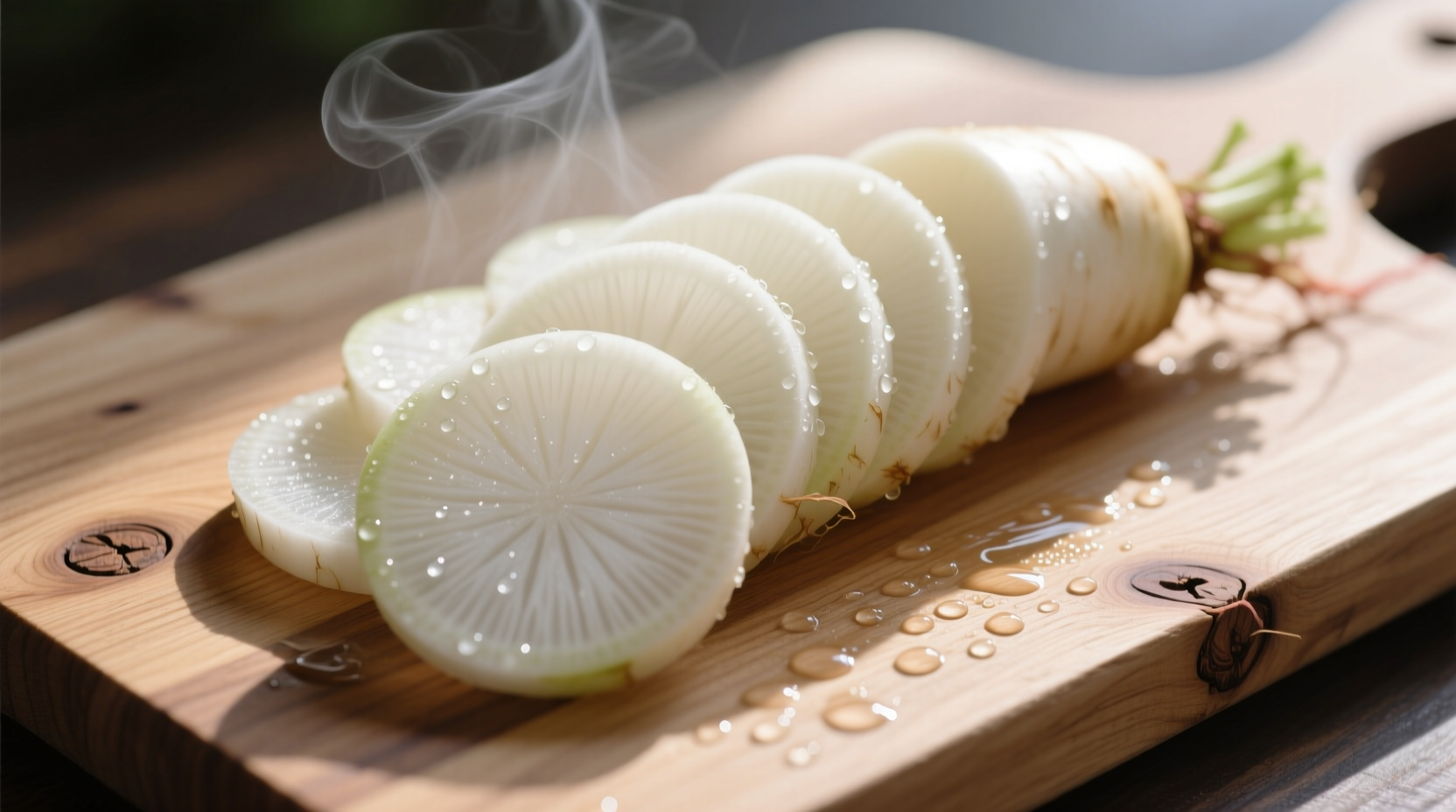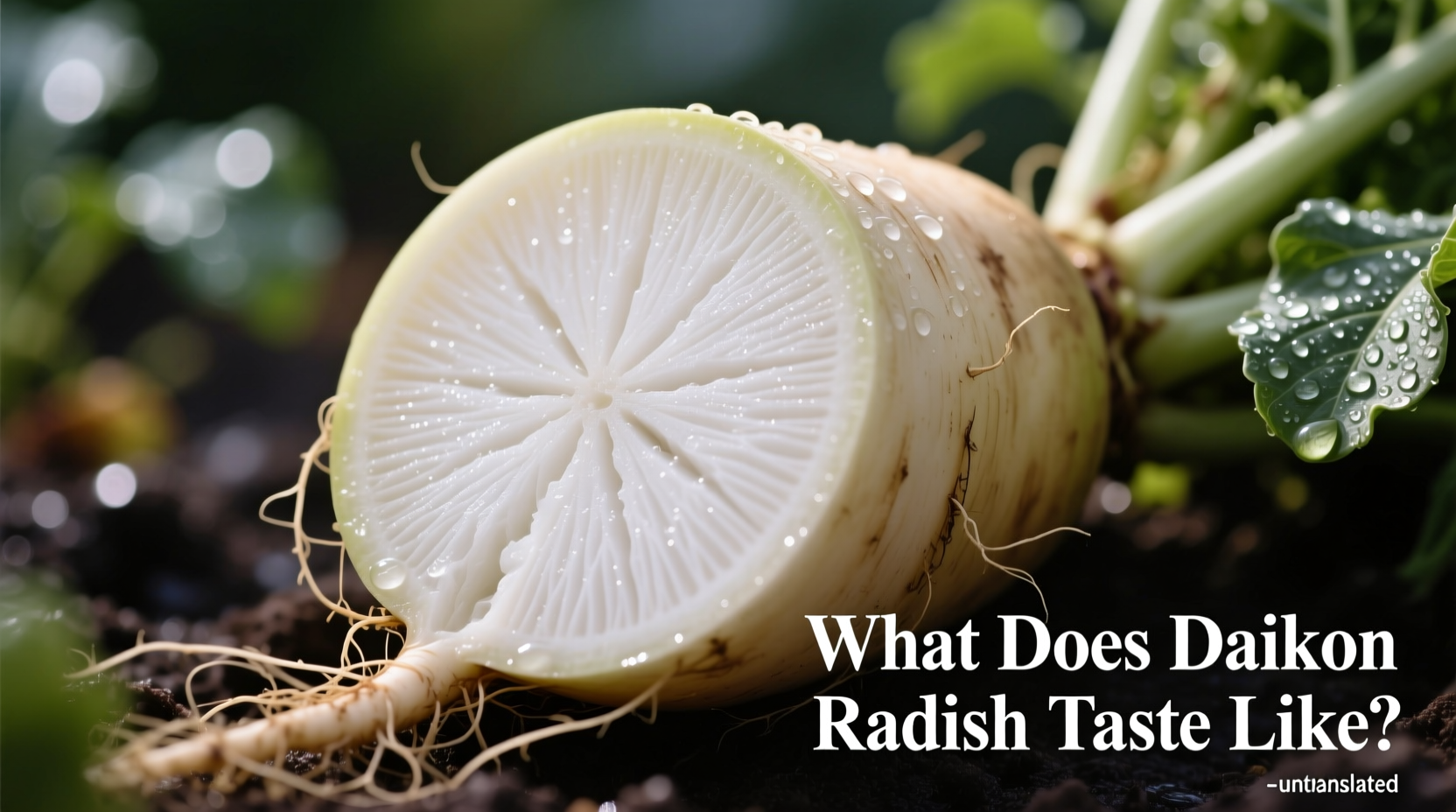Curious about incorporating this versatile root vegetable into your meals? Understanding what does daikon radish taste like unlocks its culinary potential across countless dishes. Whether you're exploring Asian cuisine, seeking low-calorie vegetable options, or looking to expand your flavor palette, daikon's unique profile offers remarkable versatility.
Breaking Down Daikon's Flavor Profile
When you bite into fresh daikon, you'll immediately notice its high water content (95%) creates a juicy crunch similar to jicama but with more nuanced flavor dimensions. Unlike the sharp bite of red radishes, daikon delivers:
- Mild sweetness – Comparable to a young turnip or mild pear
- Subtle peppery notes – Noticeable only in the finish, about 1/10 the intensity of red radishes
- Clean, refreshing quality – Similar to cucumber with less bitterness
- Earthy undertones – More pronounced in mature specimens
According to USDA FoodData Central, daikon's mild flavor profile stems from lower concentrations of glucosinolates—the compounds responsible for the sharp taste in cruciferous vegetables. This biochemical difference explains why does daikon radish taste different from regular radishes.

How Preparation Methods Transform Daikon's Flavor
Your preparation technique dramatically impacts what daikon radish tastes like when cooked versus raw. Understanding these transformations helps you leverage its full culinary potential:
| Preparation Method | Flavor Transformation | Best Culinary Applications |
|---|---|---|
| Raw (sliced) | Crisp, refreshing, mildly peppery | Salads, crudités, garnishes |
| Pickled | Tangy, slightly sweet, enhanced crunch | Sushi accompaniments, sandwich toppings |
| Stir-fried | Mellow sweetness, tender-crisp texture | Asian stir-fries, noodle dishes |
| Simmered | Rich umami, potato-like tenderness | Stews, soups, Japanese oden |
This daikon radish taste comparison by cooking method reveals why Japanese chefs call it "winter aphrodisiac" – its flavor deepens and becomes more complex with cooking, unlike many vegetables that lose character.
Seasonal Variations in Daikon Flavor
Daikon's taste profile changes throughout the growing season, following this predictable pattern:
- Early season (September-October): Most delicate flavor, highest water content, minimal peppery notes
- Mid-season (November-December): Balanced sweetness and subtle spice, ideal for raw applications
- Late season (January-February): More pronounced earthiness, better suited for cooking
University of California agricultural studies confirm that daikon harvested after the first frost develops noticeably sweeter flavors as carbohydrates convert to sugars – a crucial consideration when deciding when to use daikon radish in your cooking.
Practical Applications Based on Flavor Profile
Understanding what daikon radish tastes like helps you make smart substitutions and pairings:
Perfect Flavor Pairings
- With seafood – Its clean flavor complements delicate fish without overpowering
- With rich meats – Cuts through fatty dishes like pork belly or duck
- With citrus – Lemon or yuzu enhances its natural sweetness
- With miso – Creates complex umami layers when simmered together
Smart Substitutions
When wondering what to substitute for daikon radish, consider these options based on preparation:
- For raw applications: Jicama (similar crunch, sweeter) or young turnip (more peppery)
- For cooking: Parsnips (sweeter) or turnips (more robust flavor)
- For pickling: Kohlrabi (similar texture, milder flavor)
How to Select Peak Flavor Daikon
Maximize your daikon radish taste experience by selecting the best specimens:
- Firmness test – Should feel heavy for its size with no soft spots
- Skin quality – Smooth, unblemished skin indicates freshness
- Size matters – Smaller daikon (6-8 inches) tend to be sweeter and less fibrous
- Leaf inspection – If sold with greens, vibrant leaves indicate recent harvest
Pro tip: Daikon's flavor intensifies from top to bottom. The upper portion near the leaves offers the mildest taste, while the tapered end has more pronounced peppery notes – useful information when preparing daikon radish for specific dishes.
Storage Tips to Maintain Flavor Quality
Proper storage preserves daikon's delicate flavor profile:
- Remove greens before storing to prevent moisture loss
- Store in perforated plastic bag in refrigerator crisper
- Can last 2-3 weeks when properly stored
- Peel only before use to prevent oxidation and flavor degradation
Unlike many root vegetables, daikon doesn't improve with long storage. For the best what does raw daikon radish taste like experience, use within 10 days of purchase.











 浙公网安备
33010002000092号
浙公网安备
33010002000092号 浙B2-20120091-4
浙B2-20120091-4